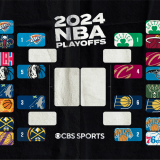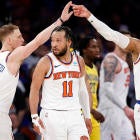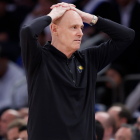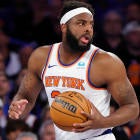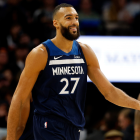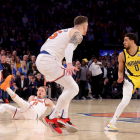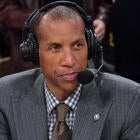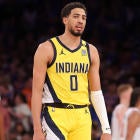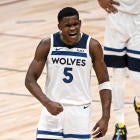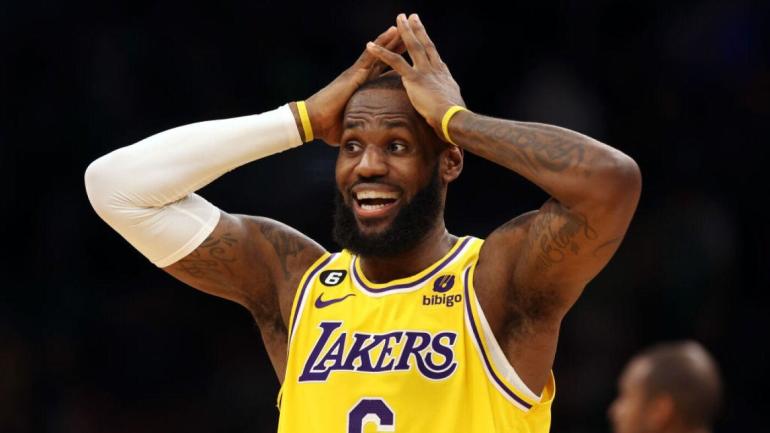
When Lakers general manager Rob Pelinka addressed the media in January, he addressed the team's trade plans with a simple and common binary: championship or bust.
"If we see a move that puts us as a frontrunner to get another championship, the 18th one here, we'll make it," Pelinka said. "And if that move doesn't present itself, we'll be smart and make it at a later time." According to Pelinka, "there's no in between or incremental growth." If they were going to make a move, it had to generate championship equity.
They made several moves in the days and weeks leading up to the trade deadline, and yet, any honest accounting of where this team currently sits in the NBA hierarchy should draw the same conclusion: the 2022-23 Los Angeles Lakers are not going to win the championship. That might sound a tad premature with more than two months of regular-season basketball left to play, but we're talking about a 25-30 team here. They had a long way to go even before the Phoenix Suns raised the bar by landing Kevin Durant on Wednesday. They needed an absolutely perfect trade deadline to even nudge their way into a corner of the championship picture.
Pelinka had an active trade deadline. In some ways, it was a pretty good one. Russell Westbrook, described by one source as a "vampire" within the Lakers locker room, is now gone. So are Damian Jones and Juan Toscano-Anderson, who weren't in the rotation, and Patrick Beverley and Thomas Bryant, who had lost favor in a crowded rotation. In their place came five players who each fill a specific niche within the Laker ecosystem.
D'Angelo Russell is the ball-handler the Lakers have spent years searching for, a qualified starting point guard in his own right capable of running the offense for stretches while also functioning off of the ball when LeBron James is in charge. Malik Beasley is the sort of deadeye shooter the Lakers simply haven't had at any point during the James era, and Jarred Vanderbilt is the kind of versatile defender that their 2020 championship roster was loaded with. Mo Bamba has been a Lakers target for several years, and he is among the few big men in the NBA who can credibly protect the rim and make 3-pointers, theoretically making it easier for Anthony Davis to play his preferred position of power forward. Rui Hachimura has already made an impact as a big wing scorer.
The Lakers are a better team today than they were when they last played on Tuesday. Maybe even significantly so. The roster, for the first time since Westbrook's acquisition, is actually coherent. Players have complementary skill sets. The roster is far more balanced positionally. Those pesky three-guard lineups Darvin Ham loves so much should be a thing of the past.
But there's a wide gap between coherent and contending. The Lakers added players that, individually, each make sense next to James and Davis. But as a collective, this is a roster designed for the regular season, not the playoffs. The regular season emphasizes strengths. Teams can't game-plan against one-dimensional players on a random Tuesday in March the way they would in the postseason because they have to play against a different opponent a night or two later. Russell and Beasley are going to give the Lakers desperately-needed spacing and playmaking. The Vanderbilt-Davis combination has the potential to be a defensive wrecking crew. There are going to be nights in which Bamba blocks a few shots, hits a few 3's and looks like a future All-Star.
But the playoffs aren't about strengths. They're about weaknesses. This is where a critical distinction comes into play. The Lakers arrived at the 2023 deadline needing 3-and-D players. What they ultimately acquired were 3-or-D players.
Beasley is a poor defender under any circumstances. Russell is miserable at the point of attack and has only ever thrived as an off-ball, back-line communicator. That's a valuable role, but it belongs to James, making Russell an awkward defensive fit in Los Angeles. Vanderbilt has attempted fewer 3-pointers in his career (78) than James did in January (99). Even the best version of the James-Davis Lakers has struggled to score when Davis has been paired with a non-shooting big man. The 2020 championship team ranked 16th in half-court points per play.
Hachimura and Bamba are a tier below that trio, valuable in theory more than practice. Hachimura frequently defended top opposing wings in Washington, but he didn't do it especially well. FiveThirtyEight's RAPTOR metric graded him as a defensive negative in his first three seasons and only slightly positive this season. ESPN's Real Plus-Minus isn't even that generous, grading him as a significant negative on the year. His athleticism and shooting form suggest he should be an effective and versatile offensive forward, so why has he spent so much of his career settling for mid-range jumpers?
Bamba's shot and shot-selection are a bit more reliable, but his defense still has a ways to go. He blocks so many shots in part because he chases those blocks. His defensive positioning is inconsistent and he's simply not mobile enough to guard on the perimeter consistently.
You can scheme around these flaws in the regular season because opponents aren't looking for them. If you can't defend in the playoffs? You get switch-hunted. If you can't shoot? You're not guarded. If you have a weakness, the best teams in the NBA are going to find it. This is part of what made the 2020 Lakers so special. So few of their role players had glaring weaknesses. Everyone played defense. The few questionable jump-shooters they did have happened to get hot at the right time. The Lakers don't win that championship without Rajon Rondo and Markieff Morris making 40 percent of their 3-pointers.
How many proven two-way players do the current Lakers have? Davis is an obvious one. James modulates his defensive effort in the regular season, but he hits another level when it counts. After that, FiveThirtyEight's RAPTOR ranks only a single Lakers player as a positive on both ends of the floor this season: Austin Reaves. The other all-in-one metrics aren't even sold. According to Dunks&Threes' EPM rating, Reaves is a negative on offense. It's a fair stance to take on a role player who, after Russell's arrival, is primarily going to be a standstill shooter. He's hit 37 percent of his catch-and-shoot attempts this season. That's good, but it's not going to bend defenses much.
On any given night in the regular season, the Lakers are going to be a tough opponent. They might even be an upset threat in any single series. But the odds of them escaping two play-in games and four seven-game series against six distinct playoff-caliber opponents without a single one of them figuring out how to exploit all of these weaknesses are infinitesimal. It's not going to happen. So why make the trades? Why sacrifice assets for a team without championship equity?
Because the Lakers have had James for five seasons now, and they've turned over the majority of their roster five separate times in that span. Aside from the James-Davis combination, the Lakers haven't built any genuine continuity in half a decade. Those two are the last players left from the championship team. Every young player they've developed in that time, except for Reaves, is now gone.
Russell and Beasley are 26. Hachimura is 25. Bamba is 24. Vanderbilt is 23. Reaves is 24. Promising rookie Max Christie is 20. The Lakers would love to compete for a championship this season, but it certainly looks as though their goal at the 2023 trade deadline was to build a team that could grow and develop to perhaps compete in 2024, 2025 or 2026. The Lakers believe in their coaching staff and developmental infrastructure. There's a reason they always have young players to toss into trades. Even if these youngsters are flawed today, the Lakers are betting that with seasoning, they can improve enough to eventually be viable in the playoffs. If that time comes, the Lakers can then invest their remaining draft capital into an all-in push.
This would be a sensible plan if James was 30 and Davis was durable. They aren't. James is already in uncharted waters. He's about to become the third player to earn All-NBA honors at the age of 38. Guess how many players have done it at 39? None. Davis has missed roughly 38 percent of the games his teams have played over the past five seasons. Both of them are free agents in the summer of 2024 and can walk if they aren't satisfied with the direction of the team.
This was, in essence, the argument for trading both their 2027 and 2029 picks unprotected and getting back as much as they possible could. James and Davis are healthy and playing at an All-NBA level right now. That might not be the case in a year. It might not be the case in a month. Championship windows are fleeting and superstars are fickle. The Lakers know this firsthand. They only milked a single year of genuine contention out of the James-Davis duo.
They had a chance to potentially get a second. The Myles Turner-Buddy Hield package was more expensive than what they gave up this week, but Turner is the sort of two-way difference maker that actually would have thrived in the playoffs, and Hield is such a transformative shooter that his defensive weaknesses might have been tolerable. Similar packages for players like Toronto's Fred VanVleet and Gary Trent Jr. would have checked the same boxes, though we don't know if such options were even on the table.
Ultimately, the Lakers landed on a half-measure. They're better, but they're not good enough. They're younger, but they gave away a premium rebuilding asset. They might be good for a few years, but it's unclear if this team will ever get to be great. It's a far cry from "there's no in between or incremental growth." The Lakers are suddenly relying on in-betweens and incremental growth, because with that 2027 pick traded, there really isn't a major move left to be made. The Lakers can improve on the margins. They can fill specific holes. But they've likely settled on the bulk of a team that isn't good enough to win that 18th championship they so covet today, and they might have no realistic path of getting there in time for the few tomorrows James has left.







